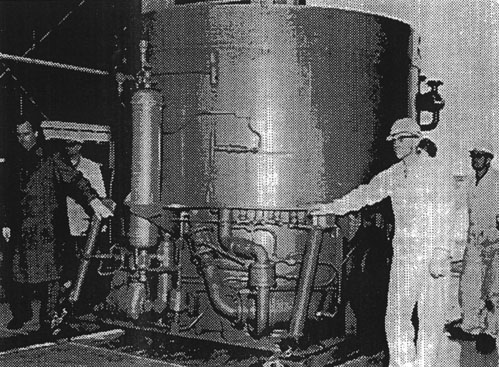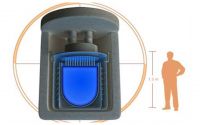This paper discusses the development of portable reactor technologies and the history behind the science and engineering of portable reactors, focusing on describing the LENR or low energy nuclear reactions associated with the development of small modular reactors. In addition, it will elaborate on the companies and governments researching small reactors, and the current status of these reactors. The paper also examines whether or not these reactors have a foreseeable future in industry and personal use and the public reactions to them thus far.
The traditional nuclear power plant requires large everything: capital, employees, security, land, and resources. What if the energy from these plants could be harnessed in a new way, a method involving a much smaller reactor? In the last 30 years, the nuclear industry has made leaps and bounds in figuring out the technology and the potential designs of portable nuclear reactors, transforming this idea from a far thought into a near reality. Compact nuclear reactors have the potential to change the way we approach nuclear energy, presenting the idea of owning and operating your own backyard reactor.
The history of portable reactors
The first attempt by the US government to create a portable reactor was the ML-1, the first gas turbine that operated with a closed cycle (Fig. 1). It was initially tested in 1961, but the reactor proved to have many unforeseen issues, like poor internal insulation and compressor malfunctions, and was eventually shut down in 1965 [1].
After the failure of the ML-1, the US government ceased its funding and focused on developing other types of nuclear energy [2]. It was not until the 1980s that the idea of portable nuclear energy emerged into the forefront again. Two scientists, Stanley Pons and Martin Fleischmann, began investigating the technology behind portable nuclear energy and rediscovered Low Energy Nuclear Reactions, or LENR. Research with LENR had first began in the 1920s and 30s, but had subsided because of the failure of the ML-1. In 1989, Pons and Fleischmann announced their findings to the scientific community, reawakening research into LENR and the idea of creating a portable reactor [3].
How does LENR work?
LENR refers to nuclear reactions that take place at standard pressure and temperature, requiring low energy to catalyze these reactions. The process of LENR reactions is separate from that of fission and fusion, where high temperature or pressures are required. LENR harnesses the energy from a weak nuclear force, like slow-moving neutrons, whereas fission and fusion employ strong nuclear forces [4]. According to the Widom-Larsen theory, LENR energy is generated in four steps [5]. First, a heavy surface electron is created by electromagnetic radiation in the LENR cells. Next, this heavy electron binds with a proton to form “an ultra-low momentum (ULM) neutron and neutrino” [5]. The ULM neutron then latches onto a free-floating nucleus, causing a chain event in which a surrounding neutron undergoes beta decay. This beta decay causes the lone neutron to disintegrate into its component parts—a proton, electron, and neutrino—and effectively turns its electron into a proton. Since every different element has its own unique number of protons, the increase in the number of protons changes the original element into another one.
NASA’s best method of creating the Widon-Larsen process involves interacting hydrogen ions with a nickel lattice (Fig. 2) [4]. In Figure 2, the metal hydride represents the nickel lattice. This lattice attracts the hydrogen gas ions while oscillating at a high frequency. These oscillations excite the electrons from the nickel and form slow moving neutrons with the hydrogen ions. The nickel absorbs these slow moving neutrons and becomes unstable, regaining stability after a neutron is removed from an electron—changing the neutron into a proton and turning the nickel into copper. This process is difficult to achieve because the lattice must oscillate at a very high frequency, generating a large amount of energy during the transformation.
Why use LENR technology and small reactors?
The advantage of LENR technology versus traditional nuclear power is that LENR requires much less energy, without the same safety hazards as a nuclear power plant. Small modular reactors require only 300 megawatts or less to operate, compared to a typical plant that uses 1000 megawatts [6]. In addition, LENRs produce no greenhouse gases or strong radiation, providing almost completely green energy [6]. With nuclear plant accidents like Three Mile Island and Fukushima, the U.S. and the world have seen the potential repercussions from radiation and nuclear waste: population displacement, lasting radiation, and millions of dollars of damage.
LENR reactions and small modular reactors eliminate the chance of any radiation because they use slow moving neutrons; slow neutrons don’t have enough energy to generate any radiation or harmful waste [4]. The portability and compactness of these small reactors mean that they could be used in remote locations or in homes or cars, as well as be manufactured in a different factory and delivered anywhere they are needed. The factories would fabricate and seal the reactors to minimize the risk of tampering, also requiring that the reactors be refueled in the factory [6]. This cycle of producing and refueling the portable reactors inside a factory would help to limit the handling of reactive material. The former U.S. Secretary of Energy, Dr. Steven Chu, even touted that “the risk of licensing and construction delays [would be] reduced” so that the reactors could be constructed much faster than a typical plant, representing “a new paradigm in nuclear construction” [6].
Portable reactors also are cost effective, presenting an affordable alternative to fossil fuel energy. Hyperion, one of the companies currently aiming to release an industrial reactor in the spring of 2014, says that their reactor would provide undeniably cheap energy. The reactor would cost about $7000 to initially purchase, with up to $1000 annually to maintain; however, the energy produced by the reactor would only cost $0.01 per kW-hour [7]. The cost aspect of the LENR technology means that this is a technology that could become widespread, used both industrially and commercially.
Current portable reactor developments
Three main designs for small reactors have emerged, all using the LENR technology: light water reactors, high temperature gas-cooled reactors, and liquid metal and gas-cooled fast reactors. Light water reactors are the easiest to transport and cost the least, making them an excellent prospect for areas that don’t have large reactors. The high-temperature gas-cooled reactors are best at providing heat for industrial processes, while the liquid metal and gas-cooled fast reactors would be best suited for electricity, heating, and water purification purposes [6]. Currently, there are 56 companies worldwide dedicated to creating and perfecting all three different designs using LENR [8]. One of the most prominent nuclear reactor manufacturers in the US, Babcock & Wilcox, is currently designing a light water reactor for household use (Fig. 3). The company argues that “every reactor brought online will contribute to the reduction of approximately 57 million metric tons of carbon dioxide emissions” [9]. The Hyperion reactor, as previously mentioned, is geared solely towards industrial usage (Fig. 3) [7]. Despite the various intended uses of these reactors, most of the small modular reactors have similar designs. They all range from three to five meters long and would be stored underground, mainly to prevent tampering, only needing to be refueled every four to five years.
As well as private companies, various governments are also investigating the technology; for example, both NASA and the Department of Energy have budgeted towards researching and building small modular reactors. A statement released by the Department of Energy claimed, “SMRs (small modular reactors) may play an important role in addressing the energy, economic and climate goals of the U.S” [11]. NASA is currently working to build portable reactors that could power lunar or martian colonies [12]. These reactors could be used to supply energy to oxygen or hydrogen generators, as well as charge devices for scouting vehicles. The solar cells currently used in space are sometimes unreliable because of the lack of light sources; however, a small reactor could generate more energy and be much more reliable.
Are small modular reactors a reality?
Although several commercial companies expect to release their reactors by 2014 and 2015, will they make an impact in the US and international markets? Carl Seligson, chairman of the consulting firm Utility Financial Experts, acknowledges that while small nuclear reactors have “some eventual hope,” they are “still many years away from commercial operation” [13]. Despite the Department of Energy’s $452 million budget towards the design of two small reactors, these reactors by Babcock & Wilcox and NuScale Power won’t hit the market until 2022 and 2025, respectively [13]. Some scientists still believe that the LENR technology is striving towards the impossible: attempting to generate too much power from such a low energy reaction. A reactor by Industrial Heat is undergoing tests by international scientists because of the controversy surrounding its newly acquired Energy Catalyser technology; much of the scientific community doubts the plausibility of the reaction that the Energy Catalyser claims to perform since it has yet to have any public test results published [14]. Even with all the recent developments and research into LENR and small modular reactors, many scientists are still questioning whether or not these reactors can achieve their desired output—some even claiming that the whole idea of LENR is a scam. Alex Xanthoulis, the CEO of Defkalion, a company working to release an SMR (small modular reactor) in 2014, concedes that “there is still resistance in belief that LENR is real” and that Defkalion’s reactor will prove the power of LENR once it debuts on the market [7]. Until small modular reactors officially become commercially available, we’ll have to wait and see whether this new form of nuclear technology can have a lasting impact and alter the energy climate of the US and the world drastically.





